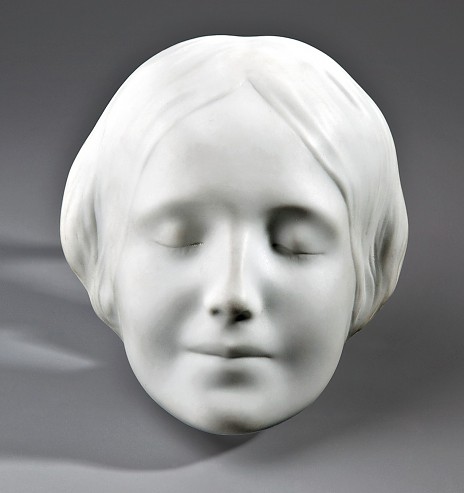The Unknown girl from the Seine
"...because it smiled so deceptively..."
l‘Inconnue de la Seine, 1920er-/1930er-Jahre
Totenmaske (?) from porcelain
Death masks are plaster or wax casts of the face of the deceased. They preserve the last, apparently authentic facial features of a person shortly after death. The tradition of the death mask is one of the earliest testimonies of almost all cultures and can be found in all geographical areas and in the most diverse forms. In some cultures the death mask was used to ward off demons. In contrast, in western societies in the 19th and 20th centuries it was usually made for the purpose of remembrance and veneration. However, they were also useful for portrait sculpture, as well as for depictions of persons on tombs and in sculptures. The real heyday began with the emerging cult of the "genius" in the Age of Enlightenment in Europe. Since then it has achieved growing popularity and spread. Since death masks were mainly taken from political personalities, thinkers, musicians, artists and writers, they represented the spiritual connection with the person portrayed. Death masks became a cult object of the enlightened western bourgeoisie.
>> By the way:
Asmund S. Laerdal, developer of mouth-to-mouth resuscitation aid, used inconnue's death mask for his rescue dummy "Anne", which is still being resuscitated day after day in first aid courses around the world.

The collection of the Museum for Sepulchral Culture includes several copies of death masks, such as those of Martin Luther, Frederick the Great, Emperor Napoleon, Ludwig van Beethoven, Frederick Hebbel and also those of the "Unknown from the Seine" (french: l'Inconnue de la Seine). It has a very special relationship with this death mask. It is the mask of an approximately twenty-year-old woman, who supposedly drowned in Paris in 1890 and were recovered from the Seine. However, the death mask turned out to be a forgery much later. Numerous stories and rumours circulated about this young woman. One of them says that a sculptor discovered her in the Paris morgue and was so fascinated by her beauty, her facial expression and her enigmatic smile that hemade a plaster mask from her face. It was common practice at that time, when the identity of a dead person could not be clarified, to put them on public display, in the hope that someone would recognize the deceased person. At the same time, death masks were also made in order to be able to further investigate after the burial of the body, just as one asks today with a photo for the identity and possible clues to a deceased person.
With the death mask of the "Unknown from the Seine" it should be different. It was reproduced in many different ways, in the most diverse materials and sizes, it even went into serial production and found a large market. A veritable cult flourished around the imprint of this young girl's head. Nevertheless, it remained a face without traces of life. The woman has no name, no social body, no history. A face full of mystery, young and beautiful, the hair on her neck pulled together, her eyes peacefully closed and her lips frozen into a smile. Many people were fascinated by this face, it decorated the homes of countless young women and artists' studios, almost as an icon. It became a popular morbid furnishing accessory in Paris and soon spread beyond the borders of France. In "Die Aufzeichnungen des Malte Laurids Brigge" (1910), the poet Rainer Maria Rilke writes, "... because it was beautiful, because it smiled, because it smiled so deceptively, as if it knew...". The meaning of her smile – it was often compared to the smile of the Mona Lisa – was as unfathomable as the cause of her death. But whoever she was, she became the subject of numerous poems, novels and novellas, such as Luis Aragon, Ödön von Horváth (A Stranger from the Seine, comedy of 1933), Alfred Döblin (Of Faces, Images and their Truth, essay 1929), Rainer Maria Rilke, but also visual artists and philosophers have taken on the unknown. The philosopher Maurice Blanchot described her as "a young girl with her eyes closed, but enlivened by such a relaxed, happy smile [...] that one could have thought she had gone into the water at a moment of great bliss". The archivist of the alleged original death mask in Paris says that it is nothing more than a "trés jolie lègende", a pretty legend. Other anecdotes claim that a researcher allegedly was able to follow the trail all the way to a Hamburg factory that made these plaster casts and thus achieved prosperity. Whether it is the mask of a formerly really living person or a freely created sculpture by an unknown sculptor, equipped with an uncertain history of origin and put into circulation for commercial reasons, remains uncertain. Only one aspect is certain and of importance for this mask: It is a woman. Thus, it is one of the great cultural and historical themes in Middle Europe such as "Death and the Girl" in the late Middle Ages or the "Cult of the Beautiful Dead" and "Water Corpse Poetry" in the late 18th and 19th centuries.
Arbeitsgemeinschaft Friedhof und Denkmal e.V.
Zentralinstitut für Sepulkralkultur
Museum für Sepulkralkultur
Weinbergstraße 25–27
D-34117 Kassel | Germany
Tel. +49 (0)561 918 93-0
info@sepulkralmuseum.de








